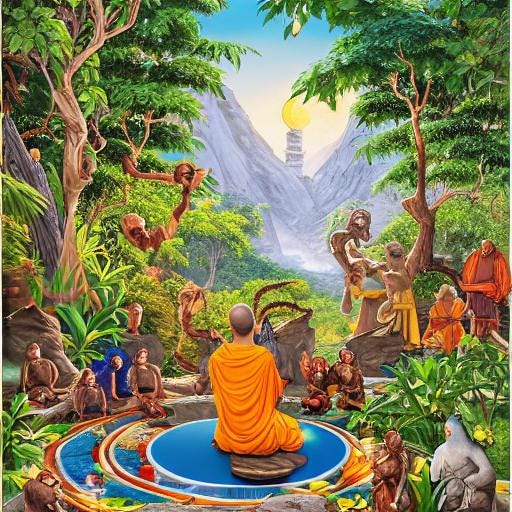Are You Trapped in Chimp Mode? : Learn How to Outsmart Your Inner Beasts
Chimps, Gremlins, and Goblins: Understanding the Creatures of the Mind
As I would describe it, the mind is a battle between a huge intricate web of nonsense we have created since childhood against the rational aware mind. Let us find the Grey Zone amidst a landscape where the “nonsense” mind moves from impulse to impulse, the cunning gremlin whispers doubts, and the wise mind observes, seeking balance amidst the chaos.
Last Monday, I triumphed over my 6-year-old nephew in a game of UNO. While my UNO skills are not the point of this story (sort of), what my nephew said afterward to my dad sparked a reflection that led me to write this newsletter.
He said, “Tell your son how he did a great job and that he is a winner.”
The Report Card Syndrome
For many of us, particularly in cultures with a strong emphasis on academic achievement, childhood was colored by the "report card syndrome."
Every mark felt like a judgment, weaving a narrative of self-worth based on external validation. That nagging voice, whispering "you're only worthy if you win," stems from a goblin deep within, a monster fueled by childhood expectations and societal pressures.
Our love and approval became contingent on a mere report card with an "A" grade. My nephew, raised in a household emphasizing "winning," treads a similar path.
But fear not, fellow explorers! We're not powerless against these internal beasts.
Let's delve into the Grey Zone, a mental jungle inhabited by chimps, humans, gremlins, and goblins, and discover how to shift from autopilot to conscious control.
The Beasts In Our Mind
Before we move on to how we can deal with this, let us understand the beasts in our minds.
Professor Steve Peters is a Consultant Psychiatrist who specializes in the functioning of the human mind. He describes the different parts of the mind as follows
The Chimp
This is the emotional and impulsive part of the brain, responsible for our fight-or-flight instincts and immediate desires. It is often likened to a mischievous chimp that can sabotage our best intentions. The emotional mind.
The Human
This is the rational and compassionate part of the brain, responsible for thinking, planning, and self-control. It is often likened to the wise and thoughtful human who tries to guide the chimp. The rational mind.
The Gremlins
These are sneaky beliefs or behaviors that, while unhelpful, are removable with conscious effort.
When you are in a relationship for the first time and the person betrays your trust and leads to a breakup, you believe that this is the end of the world and that all people are untrustworthy.
A personal gremlin I'm addressing is “crystal-ball gazing”—trying to predict the future and weaving myself into a web of unhappiness.
The Goblins
In contrast, goblins are deeply ingrained beliefs challenging to remove.
These beliefs, often rooted in childhood experiences, can shape our entire worldview. Examples include beliefs like "I am doomed to fail no matter how hard I try due to past experiences." (Report card syndrome) or "Everyone else has it easier than me."
Taming the beasts and switching to the human
Imagine your mind as a vast jungle, inhabited by two distinct entities: the chimp, representing our emotional and instinctual side; and the human, embodying our rational and logical faculties.
It's a dynamic ecosystem where emotions clash with reason, often leading to inner turmoil and conflict.
Taming the Chimp & Engaging the Human:
Pause and Reflect: When the chimp throws a tantrum, don't react. Instead, pause. Identify the emotions and motivations behind the chimp's actions. Ask yourself, "What is the chimp trying to tell me?" Acknowledge its presence without letting it control you.
"What's the Plan?": Shift from emotions to logic. Ask yourself, "What is the rational response here? What are the practical steps I should take?" Engaging the human helps formulate a strategic response.
Tools to Tame the Beasts:
Mindfulness: Picture yourself chilling on a beach, watching the waves of your thoughts roll in and out without getting swept away. Are you reacting impulsively like the chimp, seeking validation like the Report Card Goblin, or clinging to a gremlin's narrative? Observe, don't judge!
Thought Observation: Practice observing your thoughts without judgment. Notice when the chimp's voice arises and gently redirect your attention to more rational considerations. Remember, thoughts are just thoughts—they don't define you.
Reality Testing: Challenge the chimp's irrational beliefs by examining the evidence objectively. Ask yourself, "Is this belief based on facts or emotions?" This helps to counteract distorted thinking patterns and promotes a more balanced perspective.
Seek Support: Surround yourself with positive peeps who uplift you, not drag you down. Find a therapist, join a support group, or connect with fellow Grey Zone explorers online. You're not alone in this journey!
Remember: You are the boss of your mind, not your thoughts. You are not your monsters, but rather, the observer of them. With each step towards self-awareness and compassion, you unlock the wisdom within. Take a moment to step back, detach, and look at the big picture.
A thought experiment
Phone Zombie or Mindful Master? Take the 30-Second Social Scroll Challenge
Pick a social media platform you frequent. Open it, but before you scroll, pause for 30 seconds. Are your fingers twitching? Feeling an itch to see everyone's updates? Observe the impulse without reacting. Is it the chimp craving dopamine hits, or the human seeking connection?
Now, put the phone down. Did the chimp hijack your attention, or did the human take control?
Share your experience in the comments below!
Observe your daily routine. Catch yourself reacting on autopilot - phone grabs, knee-jerk responses, self-doubt whispers. Identify the beast behind it: chimp, gremlin, or goblin? We're all in this together, navigating the ever-shifting landscape of our minds.
"The mind is like a lake. When it's still, the reflection is clear. When it's disturbed, the reflection is broken." - Gautama Buddha
Regards
Skanda






